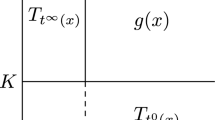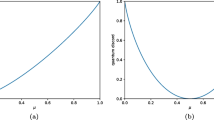Abstract
This paper explores some modifications in the Bethe ansatz which gives the analytical solution of the one-dimensional Heisenberg spin chain model. We propose a master equation for lattice momenta calculation of the two magnon state and show both analytically and numerically that using this condition how one can easily derive the lattice momenta which are real. Thereafter, we derive a total of four different cases for the class \(C_3\) solution (complex lattice momenta) of the two magnon state based on even or odd total number and half the number of spins. As an example, we show the eigenvalue spectrum of the one magnon and the two magnon state for the 32-spin system. After that, we modify the Bethe ansatz relation for more than two spins in neighboring site spin flip group for the r magnon state.
Graphic abstract









Similar content being viewed by others
Data availability statement
This manuscript has no associated data or the data will not be deposited. [Authors’ comment: As mentioned, we can provide data on reasonable request, Numerical methods were used as a tool to verify the exact solutions and the data is anyway displayed as plots and tables clearly in this paper.]
References
W. Heisenberg, Zeitschrift für Physik 49, 619–636 (1928)
H. Bethe, Zeitschrift für Physik 71, 205–226 (1931)
M. Takahashi, Prog. Theor. Phys. 46, 401–415 (1971)
J. Des Cloizeaux , J. Pearson, Phys. Rev. 128, 2131 (1962)
J. Kondo , K. Yamaji, Prog. Theor. Phys. 47, 807–818 (1972)
R. B. Griffiths, Phys. Rev. 133, A768 (1964)
C.N. Yang, C.P. Yang, Phys. Rev. 150, 321 (1966)
C.N. Yang, C.P. Yang, Phys. Rev. 150, 327 (1966)
M. T. Batchelor, Phys. Today 60, 36 (2007)
C. Kittel, Introduction to Solid State Physics (Wiley, New York, 1996)
E. H. Lieb , W. Liniger, Phys. Rev. 130, 1605 (1963)
E. H. Lieb, Phys. Rev. 162, 162 (1967)
J. Links, H.Q. Zhou, R.H. McKenzie, M.D. Gould, J. Phys. A Math. General 36, R63 (2003)
S. J. van Tongeren, J. Phys. A Math. Theor. 49, 323005 (2016)
F. Levkovich-Maslyuk, J. Phys. A Math. Theor. 49, 323004 (2016)
L. Faddeev, Int. J. Modern Phys. A 10, 1845–1878 (1995)
S. Martynov, Phys. Lett. A 219, 329–334 (1996)
M. Karabach, G. Müller, H. Gould , J. Tobochnik, Comput. Phys. 11, 36 (1997)
W. Hao, R.I. Nepomechie, A.J. Sommese, Phys. Rev. E 88, 052113 (2013)
D. Kouzoudis, J. Magn. Magn. Mater. 173, 259–265 (1997)
D. Kouzoudis, J. Magn. Magn. Mater. 189, 366–376 (1998)
J. Preskill, J. Modern Opt. 47, 127–137 (2000)
G. Vidal, J. I. Latorre, E. Rico , A. Kitaev, Phys. Rev. Lett. 90, 227902 (2003)
T. J. Osborne , N. Linden, Phys. Rev. A 69, 052315 (2004)
D. Das, H. Singh, T. Chakraborty, R. K. Gopal , C. Mitra, N. J. Phys. 15, 013047 (2013)
F. Verstraete, M. Popp, J. I. Cirac, Phys. Rev. Lett. 92, 027901 (2004)
J. Keating, F. Mezzadri , M. Novaes, Phys. Rev. A 74, 012311 (2006)
Acknowledgements
Arijit Mandal acknowledges the Theoretical Physics Group, VNIT Nagpur for providing CUDA-GPU super computing facilities.
Author information
Authors and Affiliations
Contributions
M. S. Ramkarthik conceptualized the problem, performed the initial mathematical calculations and numerical analysis, supervised the work, and modified the manuscript. Arijit Mandal performed further mathematical and numerical analysis and wrote the manuscript. All the authors have read and approved the final manuscript.
Corresponding author
Appendix A: Example of a three magnon state with \(N=6\)
Appendix A: Example of a three magnon state with \(N=6\)
Here, we provide an example for the three magnon state to describe the procedure for constructing the eigenstate of the Heisenberg Hamiltonian through the Bethe ansatz and our proposals. In Fig. 9, different possibilities of anti-parallel pair formation for a three magnon state are shown. This example will be helpful to understand the derivation of Eqs. 19, 20, 46, and 47 in the Bethe ansatz. In the following equations, the coefficients of the basis vector \(|1, 2, 3\rangle \) explain the necessity of our proposal in Eq. 85 for the r magnon state. Therefore, the eigenstate (from Eq. 44) for this case can be written as
where all the terms in R.H.S. are distributed within three square brackets. In the first square bracket, we put the basis vectors with all spins flip at other than neighboring sites. The second square bracket contains the basis vectors with two spins in neighboring site spin flip group. In third square bracket, we put those basis vectors where flipping of spins occurs at neighboring sites only. Now, if the Hamiltonian \({\mathcal {H}}\) operating on the state \(|\psi \rangle \) of Eq. 86, the following possibilities will arise. For the case (\(n_3> n_2 + 1 > n_1 + 1\)) (case (a) of Fig. 9)
For the case (\(n_3 = n_2 + 1, ~n_2 > n_1 + 1\)) (case (b) of Fig. 9)
For the case (\(n_2 = n_1 + 1, ~n_3 > n_2 + 1\))
For the case (\(n_1 = n_3 + 1, ~n_2 > n_1 + 1\))
For the case (\(n_3 = n_2 + 1, ~n_2 = n_1 + 1\)) (case (c) of Fig. 9)
Applying Eqs. 87–91 on 86, we get
Rearranging the basis vectors of Eq. 92, we can write
Now, from Eq. 93, one can easily write Eq. 46 and 85 and derive the Bethe ansatz coefficients for getting the eigenstates.
Rights and permissions
About this article
Cite this article
Ramkarthik, M.S., Mandal, A. On certain classes of exact solutions of two magnon states in the Heisenberg spin chain. Eur. Phys. J. B 95, 45 (2022). https://doi.org/10.1140/epjb/s10051-022-00304-1
Received:
Accepted:
Published:
DOI: https://doi.org/10.1140/epjb/s10051-022-00304-1





